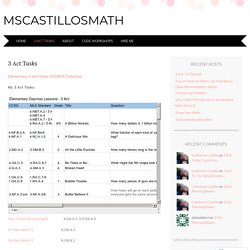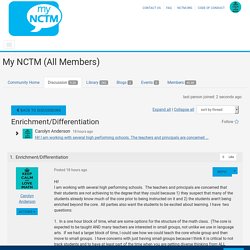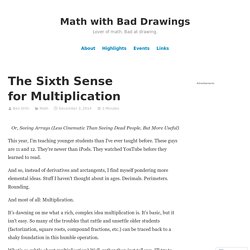

Mscastillosmath. Elementary 3 Act Tasks DESMOS Collection My 3 Act Tasks: Dart Throw (Structuring 5) K.OA.A.1-3, K.OA.A.5 On Your Mark V1 K.OA.A.3 On Your Mark V2 K.OA.A.1 Tigers and Zebras Oh My K.MD.B.3 What Comes Next?

Dart Throw 1.OA.A.1, 1.OA.B.4, 1.OA.C.5, 2.OA.B.2. Bubble Trouble 1.OA.C.6, 1.OA.D.8 The Very Hungry Caterpillars! Kids Math Talk. Twitter.
Measurement. Students’ Ideas at the Center Part 1: Knowledge is Connected – Berkeley Everett. Literacy in math. CONFERENCE SESSIONS. Gallery of anchor charts showing strategies for addition and subtraction. What do you do when students submit low quality/low effort work? I’ve been taking an online workshop to learn more about practical ways we can implement problem-based lessons in our math classrooms called Empowered Problem Solving by Robert Kaplinsky (#mathhero #teachercrush).

In one of the workshop modules we troubleshoot various issues that may arise throughout the process of teaching a problem based lesson, for instance: What happens if students don’t ask for information that they need to solve the problem? What do you do if a student shares a strategy that you don’t understand or did not anticipate? What do you do when students submit low quality or low effort work? That last question really had me thinking a lot about assessment. “What Should My Answer Look Like” Posters from MathEqualsLove I don’t make enough time for level 3 work, and I should. Mathematical Peer Editing Checklist and Feedback Form (PDF) Make a Ten Strategy for Addition. In Kindergarten, our kiddos learn their “Friends of Ten“.

In other words, they learn all the combinations that make ten (ex., 2 + 8, 3 + 7, etc.). In 1st grade, as students begin learning their basic addition facts, they apply that knowledge in a strategy known as “make a ten” to help make sense of facts that might otherwise be hard to memorize, such as 8 + 4 or 9 + 5. To use the strategy, students decompose one of the addends to make a ten from the other. Reaching New Heights. When was the last time you had to engage in an activity that required you to “unpack” mathematics standards?

Perhaps you spent hours on the task, circling verbs and underlining nouns, to end up feeling only marginally better prepared to teach the standards. In mathematics, this way of digging into standards can too easily result in unintentionally separating ideas that were intended to stay together as it ignores some of the higher-level organizing structures that reflect the coherence of the discipline. For more on this, we recommend visiting or revisiting The Structure is the Standards.
Additionally, though, unpacking also risks overlooking or reducing the intended complexity of the mathematics students should be learning. Enrichment/Differentiation. We have EXTREME need (don't we all?)

For differentiation in our school. To support teachers across grade levels, I made a doc of lesson plan templates with sample lesson plans... showing different ways of structuring a math class to better facilitate differentiation and small groups. Do This, Not That: Structuring Math Workshop. Whether you are just getting started with a workshop approach to math or you have already implemented your own version, I have some tips for structuring math workshop to maximize the benefits.

This post is the first in a series of three, so stay tuned for more! This post contains affiliate links, which simply means that when you use my link and purchase a product, I receive a small commission. There is no additional cost to you, and I only link to books and products that I personally recommend. Many teachers, frustrated with the limitations of whole-group math instruction, are moving to a guided math or workshop approach to teaching math. In this structure, teachers provide increasingly more instruction in a small group setting, while students work independently in workstations. Mathematics - Mathematics Tasks.
The Sixth Sense for Multiplication – Math with Bad Drawings. Or, Seeing Arrays (Less Cinematic Than Seeing Dead People, But More Useful) This year, I’m teaching younger students than I’ve ever taught before.

Brilliant by @BerkeleyEverett No more alligators in math class. #mathchat #MTBoS… Resources on Using Literacy Skills in Mathematics. Kaplinsky. Lessons chart 2.
Early Childhood. Grade 1. Grade 2. Grade 3. Grade 4. Grade 5. Cool math ideas & thoughts. Math facts & fluency. Number sense.
Place Value. Math night. Intervention. Have you used Achieve the Core's enVisionmath 2.0 or Wonders adaptation resources? Survey. Organizing Math Instruction to Achieve Rigor. How often have you heard or said after looking through a mathematics program, “There’s just not enough rigor”?

If you dig deeper into these thoughts, what you will find is that what is truly being referred to is “difficulty.” The issue is that “difficult” is not synonymous with “rigorous,” and more importantly, simply using difficult tasks with students does not lead to them becoming mathematically proficient. Rigor refers to a balance between conceptual understanding, procedural fluency, and application. The idea is if students understand mathematics conceptually, they will be more likely to apply procedures flexibly and precisely.
Rigor is best accomplished by teaching concepts before procedures. Math Visuals.
Recognizing and Alleviating Math Anxiety. In class, this may look like misbehaving, off-task behavior, or frequent visits to the nurse.

But avoidance may be hard to recognize because some of our math-anxious students have perfected the skill of doing very little math without drawing too much attention to themselves. Lack of response: Do you have students who seem to freeze when asked a question involving math? When students have math anxiety, any math-related question can make them feel extremely stressed. They lack full access to their working memory, making it nearly impossible for them to think clearly.
Mathematics anxiety and the affective drop in performance. Finding the Beauty of Math Outside of Class. A math trail is an activity that gets students out of the classroom so they can (re)discover the math all around us. Whether out on a field trip or on school grounds, students on a math trail are asked to solve or create problems about objects and landmarks they see; name shapes and composite solids; calculate areas and volumes; recognize properties, similarity, congruence, and symmetry; use number sense and estimation to evaluate large quantities and assess assumptions; and so on. This is one of those creative, yet authentic activities that stimulate engagement and foster enthusiasm for mathematics—and so it can be particularly useful for students in middle and high school, when classroom math becomes more abstract.
A math trail can be tailored to engage students of any age and of all levels of ability and learning styles. Its scope and goals can be varied, and it can include specific topics or more general content. A Day of Exploration.
Enrich & extend. Teaching time. Five Places for Trusted Resource Recommendations. There are huge benefits to be had from dipping your toe (or plunging headfirst) into the world of Open Educational Resources (OER).

Maybe you need to supplement your existing curriculum to identify gaps; maybe you need find a new way to reach a struggling student; maybe you’re curious about harnessing digital technology to discover exciting, tech-based ways to teach age-old content. Whatever the case, the OER and ed-tech universe can seem magical (limitless lessons and tools – and they all seem free!) Best Math Websites for the Classroom, As Chosen by Teachers. Learning math online isn’t always easy! Luckily there are some great math websites for teaching math virtually.
We’ve gathered a list of teacher-approved sites that includes resources, games, freebies, and innovative programs for teaching math. Avoiding "Learned Helplessness" We all have students that just want to "get it right. " We all have students that constantly seek the attention of the teacher. "Did I get this right? "
Mental math. Fractions. Math research. Homework. Supporting Excellence: Real Support for Teachers Starts With the District’s Curriculum – Achieve the Core Aligned Materials. Through my work with the Council of the Great City Schools, I’ve had the opportunity to visit school districts throughout the country, speaking with leaders and staff at all levels of the system. Often, what we hear in these conversations is a wide range of interpretations of district standards and instructional expectations. What is consistent, however, is that teachers and principals do not feel they have the resources and support they need.
This is one of the reasons we at the Council of Great City Schools have shifted our focus over the last year or so to ensuring that clear guidance and standards-aligned resources are actually making it into classrooms. And we feel that this work begins with the development and implementation of a strong district curriculum. When we look at curriculum documents and guidance materials written by districts, we often see missed opportunities for clarifying the district’s vision and supporting instructional staff. Homepage.
Education Week.
Discussion. Maximize learning. Problem solving. Manipulatives. Vocabulary. Questioning. Effective teaching.